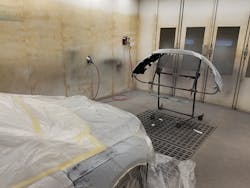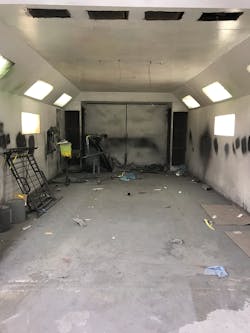Taking steps to properly maintain the paint booth inside of a body shop is crucial. Not only does this process make the booth a safer environment to work in, but it also increases throughput by consistently producing higher quality finishes versus painting in uncontrolled environments. Without a well-maintained paint booth, body shops run the risk of an inefficient repair process that results with a poor finish quality and decreased bottom line. By following a series of simple steps, you can ensure that your paint booth continues performing optimally.
The first step of the process is checking the filters. It is not uncommon to see shops with downdraft ceiling filters that are over one year old. Depending on usage, this might be acceptable. However, if you are painting a lot of cars every week, you may have reached capacity and are losing airflow. Airflow measurement readings throughout the booth should be at a minimum of 80 feet per minute; anything less could indicate poor filter performance.
Another area to check are the pre-filters. Most modern booths have them, but they are frequently overlooked. Look for any access panels with hinges or latches and you will likely find pre-filters or other serviceable items inside. These filters protect your main ceiling filters and need to be changed more often. If they are not maintained properly, you will have a much shorter life for your ceiling filters.
Floor filters or exhaust filters must be changed more frequently, as often as once a week for booths that are in constant use. Clogged floor filters can quickly cause a major loss in air movement, which will reduce production, quality and hinder the performance of paint materials — ultimately reducing profits. Overly-clogged or missing exhaust filters can lead to overspray build-up in the stacks, which restrict air flow, damage components within the stack such as fan blades and bearings, and significantly increase the risk of a fire.
Booth usage plays a role in how often filters should be changed. When they are ignored, several problems arise that result from poor air movement:
- Increased flash-times and poor curing
- Excess dirt found in topcoats and clearcoats
- Reduced air exchange, increasing the potential for solvent-pop
- Overspray contaminating other panels
- Overspray covering the walls and lights in the booth
- Reduced cycle time
Think about how you are controlling the dust build-up on the booth floor. Wetting the floor is the age-old way of keeping dust on the floor, leading to rework when the hose splashes water on the freshly cleared quarter. Additionally, introducing humidity in waterborne paint processes drastically affects performance. Dust control products designed to specifically address this issue are more efficient. Some are sprayed on the floor while others are fabric that are rolled. These solutions reduce time spent buffing and/or reworking panels. They vary in maintenance intervals, but all will increase consistency and quality. If you have a cross flow or side extraction downdraft, these floor coatings are even more important as your floor provides a major source of dust in the topcoat.
Compressed air filtration systems have another set of filters that affect booth operation and tend to be one of the more overlooked items in booth maintenance. Desiccant filters must be changed out as soon as the indicator changes color; if not, they allow moisture — and many times, broken pieces of desiccant — into the air hose and onto your paint job. Oil separation filters and air valves are items that will eventually deteriorate and fall apart and must be included on your booth maintenance checklist. These filters filter the air but do not dry it. Once the filters are full, moisture and contamination will bypass them.
Overspray is another important thing to keep under control. There are products specifically designed to reduce the build-up and dirt that collect on the walls over time. Multiple options are available such as spray-on films that can be washed off with water, spray-on films that can be peeled off, and adhesive backed fabrics that trap the dirt and overspray. Painters should position panels in the booth so they can spray towards the exhaust versus the walls and lights to extend the time between cleaning operations. This also helps with flash-off of the material by keeping panels exposed to proper air flow.
Air compressor maintenance is critical in extending your filter life by reducing contaminates that are leaving the compressor, such as moisture and oil particulates. Proper maintenance hinders contaminates from reaching the air lines, gun cleaners and booth air filters. When compressors produce large amounts of moisture and oil, rework costs will rise and production will slow. The cost of one reworked finish is often greater than the cost of replacing filters.
Your last line of defense to avoid paint job contamination is examining your hoses. They should be high quality and immediately replaced when they are covered with overspray, cracked, leaking or have reached an age limitation. Having a clearly defined change-out schedule and back-ups on hand will mitigate the risk of contamination and/or downtime due to failure. Be sure to put them off to the side of the booth when moving vehicles in and out. This is because they can break down on the inside when driven over, causing areas that typically attract dirt to release it onto the painted surface. Ideally, hoses would not be in the booth during a bake cycle as the constant fluctuation and exposure to extreme temperatures can cause them to breakdown prematurely. If an air hose specifically states it is not for use in a booth, don’t use it.
Lighting is another area often overlooked. This can happen as easily as using the wrong type of bulb or ignoring burnt-out bulbs. Painters must have the right spectrum of light to ensure they achieve proper coverage and color match. Remember that the cost of one rework will typically exceed the cost of proactive maintenance.
Deteriorated door seals and/or missing or malfunctioning latches can allow dirt to enter the spray area, as well as overspray into the shop, and increase the workload on the booth’s components to maintain proper pressure. These issues can also increase labor times for denibbing, polishing and/or reworking panels.
Following the recommendations above will help your collision center remain productive and profitable. Whether it is a simple bulb or hose change that is needed, the little things eventually add up to something more complex that can ultimately affect the business. By being proactive and going through a complete maintenance checklist at appropriate time intervals, your shop will benefit by helping to keep pace and reduce wasted time, materials, resources and money.



